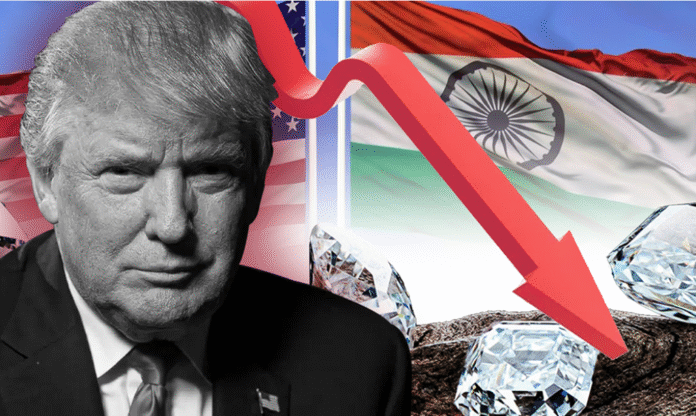rump India Diamond Tariffs Threaten the Future of Global Jewellery Supply
Trump India diamond tariffs are sending shockwaves through the world’s diamond industry, with fears that the United States’ steep new import duties could devastate India’s position as the largest supplier of cut and polished gems. For Kalpesh Patel, a small business owner in Surat the heart of India’s diamond industry this could mean closing his factory’s doors for good.
Patel employs around 40 skilled workers who transform rough diamonds into sparkling masterpieces for export. For years, his unit has survived economic slowdowns, rising costs, and market shifts. But now, U.S. President Donald Trump’s massive 50% tariff hike on Indian imports may be the final blow.
“We still have some Diwali orders to fulfill,” Patel told Al Jazeera. “But we might have to shut down before the festival if exporters cancel orders because of high U.S. tariffs. It’s getting harder to pay salaries and keep operations going.”
Why Surat Matters to the World
Surat, often called the “Diamond City of India,” is home to over 20,000 small and medium-sized cutting and polishing units. Together, they process 14 out of every 15 natural diamonds sold globally.
The U.S. is India’s largest export market for diamonds. According to the Gem and Jewellery Export Promotion Council (GJEPC), India shipped cut and polished diamonds worth $4.8 billion to the U.S. in the 2024–25 financial year more than a third of India’s $13.2 billion total in the sector.
Now, with Trump India diamond tariffs pushing the effective import duty to a staggering 52.1%, this flow could slow to a trickle.

How the Tariffs Escalated
The U.S. tariffs came in two waves. First, a 25% duty on all Indian imports was announced in April and took effect on August 7 after trade talks collapsed. Then, on August 6, Trump added another 25%, calling it a penalty for India’s continued purchase of Russian oil.
Ajay Srivastava, founder of the Global Research Trade Initiative (GTRI), called the hike “hypocrisy,” pointing out that the U.S. still trades with Russia and that China Russia’s biggest oil buyer faces no similar punishment.
A Crisis Already in Motion
The new tariffs come on top of multiple challenges the industry has faced in recent years:
-
The COVID-19 pandemic, which slowed global luxury markets.
-
The Russia–Ukraine war, which triggered Western bans on rough diamond imports from Russia.
-
The rise of lab-grown diamonds, which now sell for a fraction of the price of natural stones.
Ramesh Zilriya, president of the Gujarat Diamond Workers Union, said that wages in the sector have already been cut in half to around 15,000–17,000 rupees ($194) per month due to shrinking demand. He also revealed a grim statistic 80 diamond workers have taken their own lives in the past two years because of economic hardship.
Job Losses Could Be Massive
With more than 2 million Indians working in diamond-cutting hubs like Surat, Ahmedabad, and Rajkot, the human cost of the Trump India diamond tariffs could be catastrophic. Zilriya warns that up to 200,000 workers could lose their jobs if the duties remain.
Already, over 120,000 former diamond workers have applied for government assistance. The Gujarat state government is offering a monthly allowance of 13,500 rupees ($154) per child to families who have lost their income.
Lab-Grown Diamonds Friend or Foe?
One silent disruptor is the growing popularity of lab-grown diamonds. Created in specialized laboratories and nearly indistinguishable from natural diamonds, they cost just 10% of the price of mined stones.
“Even experienced jewellers sometimes can’t tell the difference with the naked eye,” says Salim Daginawala, president of the Surat Jewellers Association. “Many customers are switching to lab-grown because they are affordable.”
While this could help meet demand in price-sensitive markets, it’s another blow to natural diamond exporters struggling to compete.
Exports Already in Decline
In 2024–25, India imported rough diamonds worth $10.8 billion a 24.27% drop from the previous year. Exports of cut and polished natural diamonds fell 16.75%, from $16 billion to $13.2 billion.
Kirit Bhansali, chairman of the GJEPC, warns that the tariffs could disrupt critical supply chains, further depress exports, and threaten thousands of livelihoods.
“We hope to get a favourable reduction in tariffs; otherwise, it will be very hard to survive,” he said.
Impact on U.S. Jewellers
The pain isn’t limited to India. Rajesh Rokde, chairman of the All India Gems and Jewellery Domestic Council (GJC), notes that about 70,000 jewellers in the U.S. will also feel the pinch as prices rise for American consumers.
“High tariffs will make jewellery expensive in the U.S., hurting both sellers and buyers,” Rokde explained.

Can Domestic Demand Save the Industry?
Some experts see the crisis as a chance to strengthen India’s domestic market. Radha Krishna Agrawal of Narayan Das Saraf Jewellers says a stronger home market could cushion the blow from declining exports.
The domestic gems and jewellery market is currently valued at $85 billion but is projected to hit $130 billion within two years. Industry leaders are also exploring new markets in Latin America and the Middle East to reduce dependency on the U.S.
Gold as a Model
Gold provides a template for resilience. As Amit Korat, president of the Surat Jewellery Manufacturers Association, notes, strong domestic demand for gold has shielded that market from export fluctuations. If India can build similar demand for diamonds, the industry could weather future storms.
The Road Ahead
For Kalpesh Patel, the question is whether his factory will survive long enough to see any recovery. “Without help, the business will lose its shine forever,” he says.
The Trump India diamond tariffs have exposed just how vulnerable global supply chains are and how dependent millions of workers are on trade policies made thousands of miles away. Whether through diplomatic negotiations, market diversification, or domestic demand, India’s diamond industry must adapt quickly if it’s to retain its glittering place on the world stage.

